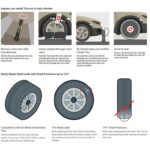How to reset the tire pressure light Honda CR-V, press and hold the tire pressure reset button until the light blinks. This button is often located beneath the steering wheel.
Experiencing a tire pressure warning light can be common, especially after a change in weather or if you’ve recently adjusted your tires.
The tire pressure monitoring system (TPMS) in your Honda CR-V plays a crucial role in ensuring your tires are safe and at the correct pressure.
A reset may be necessary after inflating your tires to the proper pressure or after installing new tires.
This straightforward process involves locating the reset button and applying a firm press for a few seconds which will recalibrate the system.
By keeping an eye on this critical dashboard warning, you maintain your vehicle’s performance and safety on the road.
Remember to always refer to your owner’s manual for model-specific instructions.
Introduction To Tire Pressure Monitoring System
The Tire Pressure Monitoring System (TPMS) in your Honda CRV plays a crucial role in your driving safety.
This system continuously tracks the air pressure within your tires. It alerts you when your tire pressure falls below the recommended level.
Maintaining optimal tire pressure is vital for fuel efficiency, reduced tire wear, and most importantly, your safety on the road.
Importance Of Correct Tire Pressure
- Improves vehicle handling and stability
- Increases tire longevity and fuel economy
- Minimizes the risk of tire blowouts
Function Of The Tire Pressure Light
The tire pressure light on your dashboard illuminates when the TPMS detects low tire pressure. This light serves as a warning to check your tires.
A simple reset procedure turns the light off once you inflate your tires to the appropriate level. Remember to check each tire to ensure the safety and performance of your vehicle.
Common Reasons For A Tire Pressure Light Warning
If the tire pressure light on your Honda CR-V dashboard illuminates, pay attention.
It indicates something’s not right with your tire pressure, which is crucial for safe driving. Here are the top reasons why that pesky light might be greeting you.
Natural Air Loss Over Time
Tires lose air naturally, which is a gradual process. It’s normal for tires to lose one to two pounds of air per month.
Over several months, this loss can cause your tire pressure light to activate. Regularly check and adjust the pressure to keep the light off and ensure safety.
Temperature Fluctuations Affecting Pressure
Changes in weather can mess with your tire pressure. Hot weather can cause expansion; cold can trigger contraction.
This seesaw in temperature could flip the tire pressure light on. Keep a close watch on your tires as the seasons change.
Leaks Or Punctures
Tire issues like leaks or punctures can be sudden. A nail in the road or a sharp object can lead to a flat tire swiftly.
Regular inspections help spot these problems before they turn serious. A quick fix from a professional can get you back on track.
Maintaining the right tire pressure ensures your Honda CR-V runs smoothly. It also keeps the tire pressure light in its place—off the dashboard. Follow these guidelines and enjoy a safe, hassle-free drive!
Initial Steps Before Resetting The Light
Experiencing a tire pressure light on your Honda CR-V can be concerning. Before resetting the light, ensure tires are in impeccable shape. This guidance prepares tires for a safe journey.
Checking Tire Pressure Manually
Kick off the process by evaluating the pressure in each tire. Utilize a reliable tire pressure gauge to measure.
The ideal PSI (Pounds per Square Inch) figures are often found on the driver’s door jamb or owner’s manual. Note the readings for all four tires.
Inflating Or Deflating Tires To Proper Psi
- Attach an air compressor’s hose to the tire valve.
- Fill to reach recommended PSI.
- If overinflated, release some air until the PSI aligns.
- Repeat for each tire, ensuring consistency.
Inspecting For Tire Damage Or Punctures
Carefully examine each tire for signs of wear or damage. Pinpoint and mark any area that appears pierced or compromised.
Small punctures can often be repaired; severe damage may necessitate a replacement.
Resetting The Tire Pressure Light
Ensuring your tire pressure is correct helps maintain your Honda CR-V’s performance.
Sometimes, after adjusting tire pressure, the tire pressure light stays lit. Simple steps can reset this light and keep your dashboard alert-free.
Locating The Tpms Reset Button
The first step to resetting your tire pressure light is finding the TPMS (Tire Pressure Monitoring System) button.
It’s often located beneath the steering wheel. Look for a small button labeled ‘TPMS’ or contains a tire symbol.
Steps To Reset The Light On Different Model Years
The resetting process may vary slightly by the year of the Honda CR-V. We’ll overview common steps and note differences where applicable.
- Turn the ignition to the “On” position without starting the engine.
- Hold the TPMS reset button until the light blinks twice.
- For models without a reset button, navigate to the vehicle Settings via the infotainment system.
- Select the ‘Vehicle’ option, then ‘TPMS Calibration’.
- Choose ‘Calibrate’ to start the reset process.
Select models may require a drive to complete calibration. Refer to your vehicle’s manual for the exact steps.
What To Do If The Light Doesn’t Reset
Here are some quick fixes if the light remains on:
- Ensure all tires, including the spare, have proper pressure.
- Drive for some time to give the sensor a chance to reset naturally.
- Consult the owner’s manual or a professional for further help.
Regular checks on tire pressure keep your CR-V in top shape. If the light persists, it could signal a faulty TPMS sensor needing expert attention.
Preventive Measures To Avoid Future Issues
Resetting the tire pressure light on your Honda CR-V is just one step toward maintaining your vehicle’s health. Taking proactive measures helps avoid future tire-related issues.
An effective strategy includes regular check-ups, appropriate tools, and understanding how different seasons affect tire pressure.
Regular Tire Maintenance Tips
Maintaining tires is crucial for safe driving. Here are tips that will keep you rolling without hitches:
- Check tire pressure monthly: Aim to do this when the tires are cold for the most accurate reading.
- Inspect tires for wear and tear: Look for any signs of uneven wear, punctures, or damage that could lead to further issues.
- Rotate your tires: Every 5,000 to 7,000 miles, rotating tires ensures even wear and extends their life.
Using High-quality Tire Pressure Gauges
To consistently measure tire pressure effectively, use a reliable gauge:
| Gauge Type | Pros | Cons |
|---|---|---|
| Digital | Precise readings | Requires batteries |
| Dial | Easy to read | Bulkier |
| Stick | Compact | Less accurate |
Pick the gauge that best suits your needs and remember to calibrate it regularly to ensure accuracy.
Understanding Seasonal Tire Pressure Changes
Tire pressure can vary with the seasons:
- Winter: Cold air can reduce tire pressure, leading to underinflated tires.
- Summer: Warm air expands, sometimes overinflating the tires.
Adjusting tire pressure during these seasonal changes is vital for maintaining optimal performance and safety.
When To Seek Professional Help
Resetting the tire pressure light on your Honda CR-V seems straightforward. Yet, certain situations demand expert attention.
This section delves into scenarios where professional aid is crucial for your safety and vehicle performance.
Persistent Warning Lights After Reset
Occasionally, the tire pressure light may remain on even after a reset. When this happens:
- Ensure you followed the reset steps correctly.
- Check all tires for proper inflation.
- Re-examine after driving a short distance.
If the light stays on, consult a mechanic, as this might signal a malfunction in the tire pressure monitoring system (TPMS).
Signs Of Serious Tire Damage
Tires are critical for road safety. Be vigilant for signs of severe tire damage such as:
- Visible punctures or cuts.
- Excessive or uneven tread wear.
- Bulges or blisters on the sidewall.
Don’t delay seeking a professional’s opinion if these signs are present. Damaged tires can lead to accidents.
Benefits Of Professional Tire Services
There’s undeniable value in professional tire services:
| Benefit | Description |
|---|---|
| Expertise | Specialists have the know-how to spot issues. |
| Equipment | Service centers have the right tools for the job. |
| Safety | Proper maintenance ensures safe driving conditions. |
| Convenience | Avoid the hassles and let professionals handle it. |
Select professional services for peace of mind and prolonged tire life.
Frequently Asked Questions For How To Reset Tire Pressure Light Honda Crv
Why Does My Honda Cr-v Tire Pressure Light Stay On?
After inflating your tires to the correct pressure, if the tire pressure light stays on, it may require a reset.
Sometimes, it can indicate a faulty sensor or a tire issue that needs addressing. It’s important to check the tires and reset the system.
How To Reset Tire Pressure Light On A Honda Cr-v?
To reset the tire pressure light on a Honda CR-V, turn the ignition to the “on” position without starting the engine.
Press and hold the tire pressure monitor reset button until the light blinks twice. Start the vehicle to check if the light turns off after a few minutes.
Can Driving Conditions Affect Tire Pressure In My Cr-v?
Yes, driving conditions can significantly affect tire pressure. Cold weather can cause tire pressure to drop, while hot weather can increase it.
Rough terrain can also lead to gradual air leaks. Regularly check the pressure to maintain safe and optimal driving conditions.
What Is The Correct Tire Pressure For A Honda Cr-v?
The correct tire pressure for a Honda CR-V is typically between 30-35 psi (pounds per square inch).
However, check the owner’s manual or the placard on the driver’s door frame for the specific recommended pressure for your model and year.
Conclusion
Resetting your Honda CRV’s tire pressure light doesn’t have to be daunting. With the simple steps outlined, you can tackle the process quickly and confidently.
Remember, maintaining correct tire pressure is crucial for safety and efficiency. So go ahead, give it a try and keep your journey smooth and worry-free.
If issues persist, don’t hesitate to consult a professional. Safe travels!

Sudatta is a passionate automotive enthusiast and expert in the field. With a keen eye for detail and a love for all things automotive, he shares insightful articles and reviews to ignite the automotive passion in readers.




